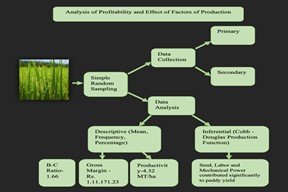Analysis of profitability and effect of factors of production in paddy cultivation in Morang, Nepal
Abstract
Paddy is one of the principal food crops in Nepal. Most of the Nepalese farmers are currently utilizing inputs in an unscientific manner due to lack of information about the most efficient use of resources, resulting in low yield and efficiency. This study was conducted for the analysis of profitability and effect of factors of production in paddy cultivation in Morang district of Nepal. A sample of 120 paddy growers were selected from 4350 paddy farmers registered in PMAMP, Rice zone, Morang using Simple Random Sampling Technique. Primary and secondary data were collected using face-to-face interview schedule and reviewing different articles and journals. Data collected were entered, tabulated and analyzed using MS-Excel and Statistical Package for the Social Sciences (SPSS). Descriptive statistics such as mean, frequency, and percentage were used to study farmer's socio-economic characteristics while inferential statistics was used in analysing the influence of production factors using Cobb-Douglas production function. The total cost of paddy production, gross income, and net income per hectare was found to be Rs.70,082.65, Rs.1,11,171.23 and Rs.41,088.57 respectively whereas productivity of paddy was found to be 4.32 MT/ha. The BC ratio 1.66 indicates that it is a profitable enterprise. The labor cost contributed most to the variable cost with 45.48%. Moreover, independent variables such as seed, labor and mechanical power contributed significantly to the yield. Therefore, paddy farming should be encouraged among farmers by increasing the availability and affordability of inputs while also improving food security.
Keywords:
BC ratio, Cobb-Douglas Production Function, ProductivityDownloads
References
Almanac, R. (2013). Rice almanac, 4th edition. Los Baños (Philippines): GRiSP (Global Rice Science Partnership).
Bhandari, D. R., Sanjel, P. K., & Adhikari, S. (2017). Policy Review of Paddy Production in Nepal. Rice Science and Technology in Nepal. Retrieved from https://d1wqtxts1xzle7.cloudfront.net/61920008/Bhandari_Sanjel_Adhikari-_Policy_review_of_Paddy_production_in_Nepal20200128-50703-13d5u9w.pdf?1580227864=&response-content-disposition=inline%3B+filename%3DPolicy_review_of_Paddy_production_in_Nep.pdf&Expire
Gairhe, S., Gauchan, D., & Timsina, K. P. (2021). Temporal dynamics of rice production and import in Nepal. Journal of Nepal Agricultural Research Council, 97-108, https://doi.org/10.3126/jnarc.v7i1.36932
Joshi, N. P., Piya, L., & Maharjan, K. (2011). Production Economics of Rice in Different Development Regions in Nepal. Journal of International Development and Cooperation, 17(1), 103-112.
Khatiwada, D., Dutta, P. J., Shrestha, K., Adhikari, G., & Paudel, H. (2021). Economic Impact of Agricultural Mechanization in Rice Farming in Shivasatakshi Municipality of Jhapa District,Nepal (Vol. 1). Food and Agri Economics Review. http://doi.org/10.26480/faer.01.2021.41.45
Magar, U. R. (2020). Identifying the Role of Paddy in the Economic Development of Nepal. The Journal of Economic Concerns, 11(1). Retrieved from http://necs.org.np/wp-content/uploads/2021/04/7.pdf
MoALD, M. o. (2021). Statistical Information on Nepalese Agriculture 2076/77 (2019/20).
Navaya, J. L. (2017). Monsoonal Rainfall and its Impact on Rice Production in Nepal. Rice Science and Technology in Nepal.
Odoemenem, I. U., & Inakwu, J. A. (2011). Economic analysis of rice production in Cross River State, Nigeria. Journal of Development and Agricultural Economics, 3(9), 469-474. Retrieved from https://academicjournals.org/journal/JDAE/article-full-text-pdf/8AAB7B68454
Pandit , R., Devkota, D., Devkota, N. R., Bhattarai, P. C., & Shrestha, H. K. (2020). Dynamics of Rice SSub-sector in Nepal: Research Investment, Production and Suply Chain. Agricultural Science and Technology, 12(2), 178-188. https://doi.org/10.15547/ast.2020.02.030
PMAMP. (2076). Annual Progress Report (2074/75 & 2075/76). Project Management Unit (PMU).
Thapa, K., Adhikari, P., Poudel, M., Adhikari, P., Baral, S., & Paneru, N. (2021). An Assessment of Farm Mechanization Status of Rice Cultivation in Ratuwamai Municipality, Morang District, Nepal. Tropical Agrobiodiversity. http://doi.org/10.26480/trab.01.2021.22.29
Yusop, Z., Aziz, A. S., Saili, A. R., Nor, R. M., & Sahmat, S. S. (2021). Constraints of Paddy production Among Smallholder Farmers. International Journal of Service Management and Sustainability, 6(1), 107-119, https://doi.org/10.24191/ijsms.v6i1.12881

Published
How to Cite
Issue
Section
Copyright (c) 2022 Agriculture and Environmental Science Academy

This work is licensed under a Creative Commons Attribution-NonCommercial 4.0 International License.

